| Avoiding Spam Emails |
Here are a few tips to avoid spam emails
|
| Backing Up your Data |
Why Should I Backup?
To back-up is to make spare copies of files and store them separately to the originals. Computers have a tendency to go wrong from time to time, these days total hard drive failure is rare but it does happen.
Operating system failure and bad software installation are other things that can cause problems when it comes to recovering files.
How frequently you back up will depend on how often you use your PC and what you use it for. The average home user will probably just have to back up any important files as and when they are changed and do a full back-up once a week/month (depending on PC use).
When PCs are used in a home office scenario then backing up should be done more frequently.
One rule of thumb would be if you're important files change daily, back-up daily, if they change weekly, back-up weekly, and so on.
Backup Devices
Floppy Disks
Floppy disks are great for backing up small files, the average 3.5" floppy disk can hold up to 1.44 Mb of data, which is sufficient for any letters or important text documents.
Backing up with floppy disks is as simple as copying the file, or saving the file to the floppy drive, a ZIP program such as Winzip can be useful to compress any files that are too big to fit on a standard floppy disk.
CD Writers
With CD Writers becoming ever more affordable, these are ideal for making back-ups of large amounts of data, with typical CDR disks holding up to 800Mb of data and costing pennies.
CD Writers are also very easy to use, the software that comes with them is normally very straight forward and can create back-ups in minutes.
ZIP Drives
Zip drives are still a popular media for backing up data, both internal and external ZIP drives are available and some models can store up to around 750MB of data. These drives normally come with their own special software which is usually very simple to use.
Backup Software
There are many back-up software packages available, they are reasonably priced (compared to a lot of software) and can be invaluable if you have very important files. One of the advantages is that most back-up software makes it simple to back up whole drives including operating system files with a few clicks. This means if the worst was to happen you could have your PC system up and running again within minutes.
| Bits and Bytes |
Kilograms, Meters are measurement unites for weight and length. Similarly Bits, Bytes and Kilo Bytes are used to measure capacity of your computer.
What is a bit?
A bit is the smallest unit of data on a Computer. A bit can hold only one of two values: 0 or 1.
Bits are usually assembled into a group of 8 to form a byte. A byte contains enough information to store a character, like "a".
What is a byte?
A single byte is composed of 8 consecutive bits capable of storing a single character.
1 kilobyte (KB) = 1024 bytes
1 megabyte (MB) = 1,048,576 bytes
1 gigabyte (GB) = 1,073,741,824 bytes
Example.
A floppy disk has 1.44MB . This means it has 1.44x1024 KB storage capacity.
Now you know the meaning of a Computer advertisement with 40GB Hard Disk
| Computer Hardware Components |
Identifying PC Computer parts
This guide will provide you with first hand knowledge of major Computer hardware components.
Specific computer hardware components can have various types and models. For an example a Computer Processor has different brands such as Intel and AMD. Within Intel there are generations such as Pentium, Celeron etc.
Today, due to the rapid development of Computer technology, assembling computer hardware components and building a computer has become a very easy task. Operating systems such as Windows XP can easily identify new PC Computer parts and configured itself. This is called Plug & Play.
Ok here we go. Below are major Computer hardware components inside a Computer.
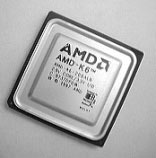 |
The Processor This is the "brain" of your Computer. An extremely sophisticated piece of miniaturized electronics, the processor (often called the CPU or Central Processing Unit) is at the bottom of all tasks the PC performs. The processor reads instructions (commands) from memory that tell it what it needs to do to accomplish the work that the user wants, and then executes them. Intel is one of the major manufacturers of Computer processors. |
 Memory or RAM Memory or RAM RAM (Random Access Memory) holds all of the "active" information that the computer is using. Memory is empty when your PC is switched off then each program or data file used grab part of the system memory. When you close a program the memory grabbed by that program is freed up. Generally, the more memory your system has, the more things you can do with it simultaneously. Increasing the amount of memory in the system also improves performance in most cases. Even though it is a Computer hardware component, RAM is also like human memory. Imagine you are reading a book. When you start reading a book the content of the book remains in your memory. But it goes away when your attention goes to somewhere else. |
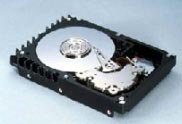 Hard Disk Hard DiskHard Disk is the computer's permanent storage capacity. Size of the Hard Disk determines how many files pr programs can be saved in your computer. Unlike RAM, you can store your files permanently in the Hard Disk until you remove them. Ex: Take the example under above Memory section. Hard Disk is similar to the book, because the items written in the book are permanent. |
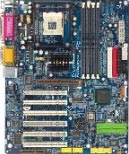 Motherboard Motherboard The motherboard is the main circuit board inside your computer. All other PC computer parts are connected to specific slots on the Mother Board. Sometimes it is called as the Main Board. Motherboard has in-built chips. One of it holds the computer time. Motherboard also has a battery, which will enable it to function some tasks such as maintaining the system time even when the PC is switched off. In addition to above there are other computer hardware components known as add-on cards. These PC computer parts are commonly known as PCI cards. They are using software called "drivers" to communicate with the operating system. Operating Systems such as Windows XP maintains a driver database to configure these computer hardware component cards. However, you will get the manufacturers driver CDs at the time of purchasing these cards. Add-on cards are fixed to specific slots on the Motherboard. Windows can immediately identify when you fix a new card and search its driver database to install a suitable driver for the new card. It will ask you to insert the manufacturer's CD if there is no suitable driver found in the database. |
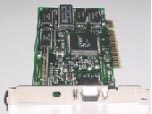 Graphics Card (VGA card) Graphics Card (VGA card) This is the device that sends the output to your monitor. You fix the monitor cable to the back of the VGA card (VGA port) in order to get the display. Please note that some of the computers have the VGA card built-in with the motherboard. You won't see a separate card for VGA in these computers. There are slots on the Mother Board to fix the graphics card. VGA card has its own memory to hold graphics and videos. It is important to have a VGA card with high memory if you want to play latest PC games. |
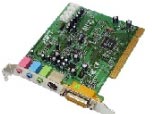 Sound Card Sound Card This computer hardware component is used to send the sound to your speakers. This is the card that you plug speaker cables. Sound card also built-in to the Mother Board in some PCs. Having a quality sound card is a must for latest games and especially if you are using your PC to watch movies and listen to music. |
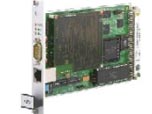 LAN Card LAN Card LAN card (Network card) is used to connect your PC to a Network. Some broadband modems also can be connected to the PC using LAN cards. Most of the new LAN cards are using a port called "Ethernet port" which is in the back of the card. Network cables are required to connect a PC with a LAN card to rest of the computers or to a broadband modem. |
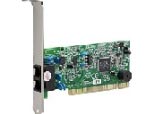 Internal Modem Internal Modem Internal Modem is used to connect your computer to the Internet. They are using the dial-up method. There are two types of dial-up Modems known as Internal and External. Internal Modem is fixed inside the PC and you fix the phone cable to the backside of it. These modem cards are disappearing fast with the introduction of high-speed broadband technology. |
| Clean up Internet Explorer Files and Browsing History |
Have you ever tried to log onto the Internet using MS Explorer for Windows and had a hard time getting online? Perhaps the computer you were using was running a bit slow, but your internet connection was fine.
So why do our computers get so sluggish every once in a while?
Think of this: every time you view a web page on your computer browser it has to download all of the files. Many times, it will cache, or save these files so the next time you access the same page on the web it loads much faster.
Unfortunately this process is also self defeating. As many computers fill up their memory entirely with these cached files and begin to run slow as a snail. Here is how you easily get rid of this clutter once and for all!
Step 1:
Open Internet Explore on your desktop. This may take a few seconds or a few minutes for Windows to open.
Step 2:
Access the tools. On the upper middle of the screen there is a menu bar with several commands. Left-click the tab that is labeled, "tools."
Step 3:
Delete browsing history. A drop-down menu will open which has several commands. The command at the top is labeled "delete browsing history" left-click this command.
Step 4:
Select delete functions. The delete browsing history box will open and you will be able to select from many files to delete. Left-click the "delete all" button in the lower left-hand corner of the box. This may take anywhere from a few seconds to several minutes for you computer to process.
Step 5:
Reboot computer. Now that all of your extra files are gone, restart your computer to optimize the speed.
| Connect to Wi-Fi (Wireless Networks) |
You can find many places that offer free wireless connections. Just how do you connect once you get there? Here are a few helpful tips that will help get you there.
Step 1:
Some computers connect automatically. The only thing that you have to do is make sure the wireless in your computer is turned on. There should be a button with an indicator light near your keyboard. If you have trouble locating it, refer to your user's manual for the location.
Step 2:
For older computers more steps are needed. With a computer running Windows open your start menu and find "network" or "internet connections". There should be an option for wireless that you can click. Your computer will search for wireless connections and you will be offered a list of options. Find the connection in the list for the location that you are at. Once you click it you will be connected.
Step 3:
For wireless connections that have passwords the wireless wizard is your best option. It will allow you to first enter the SSID which is the name of the network. Usually the SSID and password are posted in locations where the access is free. The SSID is the name of the network. Keep clicking next through the screens and enter the user name an password in the indicated fields.
| How to Defragment a Hard Drive and Optimize Virtual Memory |
Defragging your computer can optimize its performance. When your computer seems to be running slow, defragging your hard drive will save you a considerable amount of time. This consolidates files that have been broken apart and spread around the computer.
Step 1:
Select "Start" from the bottom corner of the screen. A pop up window will appear with several options, including All Programs. Select "All Programs" by clicking on it or holding the mouse over the option.
Step 2:
Click "Accessories" for the next window to appear. It may appear to either side of this menu with another window. Select "System Tools" and then "Disk Defragmenter" from the following pop-up menus.
Step 3:
Pick the hard drive you wish to defragment in the Disk Defragmenter window by highlighting it and clicking once.
Step 4:
Select "Analyze" to see how much space you will be gaining by going through with the defragmentation. If the results come back and say that defragmentation is not necessary you can choose to go ahead and do it, or choose other ways to optimize the hard drive.
Step 5:
Choose "Defragment" if the results of the Analyze process said that it would be beneficial. This process takes quite a bit of time depending on how large the hard drive. Be sure you don't need to access you computer for anything while it is defragging. Click "OK" when the process is completed.
Step 6:
Change the size of the Virtual Memory Paging Size by selecting "Start", "Control Panel", "System" then go to the "Advanced" tab.
Step 7:
Click the "Settings" button in the Performance box and a Performance Options window will appear. Again select the "Advanced" tab at the top of the window. Choose "Change" in the Virtual Memory box. The next window is where you can customize the paging file size for each of the drives. Reboot the system for changes to take effect.
| How to Switch to Firefox from Internet Explorer |
If you're tired of the slow downs and errors of Internet Explorer, then maybe it's time to try something new, possibly safer and more efficient. It's a free web browser called Mozilla Firefox. It's a good idea to have more than one web browser anyway; so why not give this one a try?
Step 1:
Go to http://www.mozilla.com
Step 2:
Once there, click the large button on the screen labeled "download Firefox--free." Then wait for the download to begin. A dialog box then appears that asks "would you like to save this file?" Click the "save file" button on the left.
Step 3:
Once the file is downloaded, click install and follow the on screen step by step prompts. Your browser will restart with Google.com as your home page. If you would like to change this, go to "tools" on the top menu and select the "main" tab.
Step 4:
Type in your new home page web address and click the OK button on the bottom of the screen to save this new address. The next time you open Mozilla, the page should automatically default to this.
Step 5:
You won't notice many differences in using Mozilla but you may not be able to access some websites that are not compatible with Mozilla; so keep Internet Explorer around. The buttons may be a bit different, but you can still have all the toolbars on the top of it, such as yahoo and Google.
Step 6:
Your "favorites" are now known as "Bookmarks" and can be located under the Bookmarks menu. To save a favorite page, clicks "bookmarks," and bookmark this page. You can also organize by placing it into a folder, similar to the process in Internet Explorer.
Step 7:
HELP! Don't worry, menus are virtually alike in this web browser as to Internet Explorer, but if do you get stuck, click the help menu and explore the choices beneath it. You can also search by topic if you are looking for something specific.
Step 8:
Firefox also has a neat feature called "Foxmarks" where you can install an add-on (by accessing the tools menu), save a username and password and then access your favorites on any computer with Firefox by entering your username and password. This is an invaluable feature and built right in to the browser.
Step 9:
MOST OFTEN USED FEATURES: If you would like to make the text size bigger, simply click the "view" menu on the top of your screen and then select "text size." If you would like to go back to your starting (home) page, just click the house on the top of the page. If you would like to refresh the page, hit the F5 key. The back and forward button functions remain the same. History is also the same. You can set the number of days, etc. and customize it to your needs. You can still save passwords inside the browser if that is something you prefer to do.
| How to tell what is running on your Computer |
Different operating systems have different ways of showing this. This guide will cover Windows XP and Windows Vista. TIP: Rebooting your PC will clear out anything that you started since your last reboot, but for this guide lets just cover the steps.
Step 1:
Windows XP Startup List The best place to start is with the startup list. Click Start > programs > Startup. Everything you see in this list will start every time your PC does. Acrobat and MS Office always add needless startup items to your list.
Step 2:
Task Manager - Press these keys together Ctrl+Alt+Del then click Task Manager.
Step 3:
Click the Application Tab. This is every application you have running. Even if you do not think it's running, it is running. Some programs run in the background. Some drop an item in your system tray (by the clock), while others wont show you anything at all.
Step 4:
Click the Processes Tab. In this screen you can see the name of every process that is running. One program or application could be running several processes. The process may have additional information under description. Read this for more details.
Step 5:
It's very likely you will see processes that you cannot identify. If you see a process and want to learn which service is connected to it, right click the process and pick "go to service". If you want to kill a process, right click it and pick end Process. If a process can not be stopped, it means windows need's it to keep running so leave it be.
Step 6:
Windows Vista Users Windows Vista users have the same Ctrl+Alt+Del to task manager as XP users but Vista gives you new tools that makes managing the performance of your PC quick and simple.
Step 7:
Click Start > Type "performance" Click performance and information tools Click Manage Startup Programs From here you can control, approve or deny any program trying to start on your PC.
Step 8:
While in Performance and Information Tools, you will have also have access to 'adjust visual effects, Adjust [search] indexing, adjust power settings, Disk Cleanup, and advanced tools. Advanced Tools allows access to event logs, performance monitor, task manager, disk defragmenter, and generate system health report. Click "view advanced system details in system information and you will be taken to a table that shows a wealth of information about your computer including hardware, software, and resources.
| Operating Systems |
What is an OS?
An Operating system (OS) is the control language used to run computers. Some examples of Operating Systems are: Windows 98, Windows XP, Windows Vista, DOS, Linux, UNIX and Apple Mac OSX They are the first software we see when we turn on the computer, and the last software we see when the computer is turned off. The OS can issue commands to computer parts (hardware) and send instructions to perform tasks. In other words the OS can talk to hardware devices in your computer. Also it translates messages issued from your hardware to English or any other languages used by human. For an example lets say you want to save a document. So you press save button. The Operating System will take your command and send an instruction to the processor to save your file. The processor co-ordinates with the hard disk and saves your file. In a nutshell, the OS controls the entire operation in your computer from the moment you turn it on, to the moment you turn it off.
Suggestions for Choosing an Operating System
An Operating System is essentially the path through which a computer accesses files, games, the Internet, and all vital stored information. The OS is the most important program on a computer because it runs all of the other programs. The major operating systems are Microsoft Windows, Mac OS X, Linux, and UNIX. The operating system is essential to the computer, and so extreme care should be taken when choosing an operating system.
Consider Its Use
Consider what operating system will be used for. If the OS is for a business, an operating system that can handle important business data should be selected. If the OS is for a college student, one might consider an OS that is optimal for gaming, yet still has a nice word processor. Finally, if the operating system were for a new computer user, then a user-friendly, simple OS would be best. Knowing this, one must also consider what software is available for the operating system. Some software is only available on certain computers. This often leaves Macintosh OS X, Linux, and Unix in the dark because most of the computer market runs on Microsoft operating systems. Most computers come standard with a certain operating system (Apple computers have Mac OS X and most PCs have Windows XP). Therefore, it is sometimes important to consider the OS even when selecting a computer.
Security
Security is the biggest priority for many computer users, especially businesses. Some OS have stronger security than others. Macintosh has been called "the iron man of operating systems" because of its ability to keep hackers out, while Windows has been criticized for being easy to hack. Do not let security completely deter you, however. Most operating systems can be "hardened" and with constant security updates, made safer from hackers.
Pros and Cons of The Big Four
Every operating system has its positive and negative elements. There is no perfect operating system. Keeping this in mind, consider the most common operating systems (Mac OS X, Windows, Linux, and Unix). Mac OS X is great for keeping out hackers and for graphic design. However some problems are the fact that certain software is not available for Macs. If the OS is for a college student who would rather play Half-Life 2 than study, then Mac OS X is not the best choice. Windows is very good for compatibility, since most consumers use Windows. Windows also comes with applications like Microsoft Word, PowerPoint, Excel, and Internet Explorer. Unfortunately, Windows is weak against viruses and can get bogged down easily. Unix is good for networks, especially if for businesses. Unix has also been around for almost 30 years, so it is quite dependable. One drawback of Unix is the cost, which can sometimes be a bit expensive. Unix is also complicated, which can confuse beginners. The final OS, Linux, is free and completely customizable. However, one major drawback is the extreme scarcity of applications for Linux. Microsoft and other software developers are often very reluctant to release their products for Linux.
Conclusion
Whatever operating system one chooses, it needs to be the system that will best fit the needs of the consumer. All operating systems have good and bad elements. Understanding how each system works, and the system's pros and cons is a must for anyone deciding on a computer and OS. An OS selection based on research and understanding will certainly yield the highest satisfaction.
| Surge Protection |
Do I need Surge Protection?
Most people don't even think about surge protection when they buy a PC, but when you go out and spend a lot of money on a machine it is wise to think about protection.
Below are some of the reasons why :
|
Surge protection units come in various shapes and sizes, the most common is similar to an extension lead, and some have built-in protection for data lines too.
When you choose one take into account the amount of outputs you will need and if you want any data protection as well, some of them boast certain specifications, but the cheaper ones barely live up to it.
